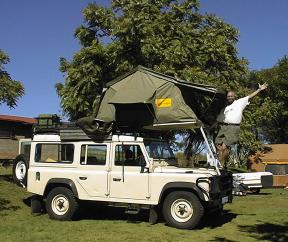
Kruger National Park
October 9th - October 17th, 1999

With all of our preparations complete, finally it's time for us to for hit the safari trail. We head east from Pretoria towards a small town called Graskop nestled in the heart of the Klein Drakensberg. Not only is it along the route to Kruger National Park, it's also the region where the highveld ends dramatically and gives way to the eastern lowveld. Prime South African vacation territory, the Klein Drakensberg is filled with tourist sights and can't be missed. The facilities here also allow us to test out our safari equipment in a nice, soft environment (just in case we forgot something).
 The difference in elevation between the highveld and lowveld
is nearly a thousand meters, and when you have a sudden drop of a kilometer,
you end up with some dramatic scenery. Klein Drakensberg is well watered,
so lush vegetation and waterfalls are the norm. Within a stones throw of
Graskop lie the Pinnacle (below left) and God's Window (below right).
The difference in elevation between the highveld and lowveld
is nearly a thousand meters, and when you have a sudden drop of a kilometer,
you end up with some dramatic scenery. Klein Drakensberg is well watered,
so lush vegetation and waterfalls are the norm. Within a stones throw of
Graskop lie the Pinnacle (below left) and God's Window (below right).
 |
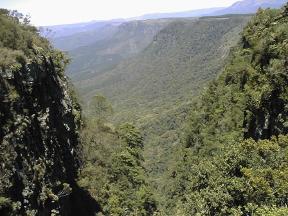 |
Below is a shot of the waterfall that creates Bourke's Luck Potholes, a series of cylindrical pools etched out by the rushing water.

Perhaps most breathtaking are some of the overlooks of Blydepoort reservoir and the Three Rondavels, a series of rock cylinders nestled in the canyon's walls. Below is a panorama we've patched together; click on it to see a more detailed jpeg (about 120K in size).
Kruger National Park
 To the east of the highveld and forming much of South Africa's
border with Mozambique lies Kruger National Park, one of the world's oldest
and largest wildlife preserves. Founded in 1898 as Sabie National Park by
Kruger himself, it was formed in response to the dramatic drop in the number
and variety of wildlife seen in the 19th century all over Africa. Now the
size of the country of Israel, it allows South Africans an opportunity to
experience the veld as it once was.
To the east of the highveld and forming much of South Africa's
border with Mozambique lies Kruger National Park, one of the world's oldest
and largest wildlife preserves. Founded in 1898 as Sabie National Park by
Kruger himself, it was formed in response to the dramatic drop in the number
and variety of wildlife seen in the 19th century all over Africa. Now the
size of the country of Israel, it allows South Africans an opportunity to
experience the veld as it once was.
 Kruger, just like the highveld we've just come from, is a
total motor tourist experience. The camps where one stays are secured from
wild animals by electric fences, so in order to see the wildlife one must
set out in your vehicle and "cruise for critters." All the main
roads are paved, and even the 4WD tracks are pretty nice dirt roads, so
while Spot's four wheeling capabilities didn't come in handy, the high seat
height that comes from sitting in a Land Rover was very nice for animal
spotting. To the left we have a fish eagle searching for food in a very
dry savanna, and to the right a pair of lions hide in the shade.
Kruger, just like the highveld we've just come from, is a
total motor tourist experience. The camps where one stays are secured from
wild animals by electric fences, so in order to see the wildlife one must
set out in your vehicle and "cruise for critters." All the main
roads are paved, and even the 4WD tracks are pretty nice dirt roads, so
while Spot's four wheeling capabilities didn't come in handy, the high seat
height that comes from sitting in a Land Rover was very nice for animal
spotting. To the left we have a fish eagle searching for food in a very
dry savanna, and to the right a pair of lions hide in the shade.
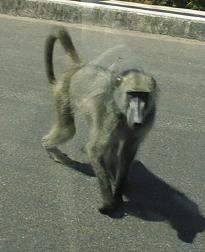 The rule in Kruger is to never leave your vehicle; your car
is your sole protection from the animals. There are a few lookouts and blinds
where that rule is relaxed, and one bridge overlook in particular had signs
labeling it as an "experiment." Intrigued, we parked on the bridge
and walked around on it -- that is, until we heard a very large bang come
from underneath it. We know we're newbies to African wildlife, so we decided
not to go investigate but rather jumped back into Spot to see what happens
next. From the opposite side of the bridge hops out this very large male
baboon, who obviously was trying to distract us so he could gain access
to our truck. With us safe inside with the windows rolled up, we took this
picture as he sauntered towards us and just before he jumped on top of the
truck. Starting up and driving away was enough to make him hop off, and
thus ended only the first of many, many baboon encounters.
The rule in Kruger is to never leave your vehicle; your car
is your sole protection from the animals. There are a few lookouts and blinds
where that rule is relaxed, and one bridge overlook in particular had signs
labeling it as an "experiment." Intrigued, we parked on the bridge
and walked around on it -- that is, until we heard a very large bang come
from underneath it. We know we're newbies to African wildlife, so we decided
not to go investigate but rather jumped back into Spot to see what happens
next. From the opposite side of the bridge hops out this very large male
baboon, who obviously was trying to distract us so he could gain access
to our truck. With us safe inside with the windows rolled up, we took this
picture as he sauntered towards us and just before he jumped on top of the
truck. Starting up and driving away was enough to make him hop off, and
thus ended only the first of many, many baboon encounters.

Another animal one finds throughout the park are elephants. Kruger, like
much of southern Africa, has experienced a dramatic rise in elephant population.
Elephants are one of the most destructive animals in Africa, breaking and
uprooting trees where ever they go. With almost twice as many elephants
as the park can comfortably support, forests stripped of all trees and vegetation
are a common sight here.
One of the most graceful and beautiful animals in Africa has to be the giraffe. Fortunately, they're very common in Kruger, and one often comes across herds of them. You also see them grazing with other herbivores such as zebra and wildebeest.
|
 |
 During the daylight hours, many of the animals you see are
asleep or resting, usually in the shade to avoid the strong midday sun.
Carnivores and reptiles in particular; during our drives we not only caught
lions snoozing but hyenas and very large lizards (a meter long!).
During the daylight hours, many of the animals you see are
asleep or resting, usually in the shade to avoid the strong midday sun.
Carnivores and reptiles in particular; during our drives we not only caught
lions snoozing but hyenas and very large lizards (a meter long!).

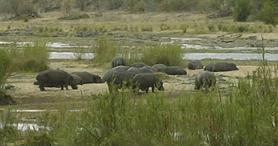 If one were to ask you "what is the most dangerous animal
in Africa?", what would you say? Lions, elephants, cobras? Well, it
turns out that more people are killed every year by hippopotamus than any
other animal. Yes, we were surprised too. Seems they're very territorial
animals, and don't respond to intrusions well. Kruger is designed to keep
the hippos and humans well separated, although you can see plenty of hippos
if you like. Here's a rare shot of hippos out of the water during the day.
If one were to ask you "what is the most dangerous animal
in Africa?", what would you say? Lions, elephants, cobras? Well, it
turns out that more people are killed every year by hippopotamus than any
other animal. Yes, we were surprised too. Seems they're very territorial
animals, and don't respond to intrusions well. Kruger is designed to keep
the hippos and humans well separated, although you can see plenty of hippos
if you like. Here's a rare shot of hippos out of the water during the day.
 One of our more delightful discoveries in Africa are baobab
trees. Local lore has it that they are descended of trees that in the early
days displeased god so he tore them all up and threw them back to earth
upside down. They grow to be very old, but the wood from them is unusable;
once they die, they disintegrate to pulp. This one pictured here is the
first one we've seen and claims to be the southernmost baobab tree in the
world.
One of our more delightful discoveries in Africa are baobab
trees. Local lore has it that they are descended of trees that in the early
days displeased god so he tore them all up and threw them back to earth
upside down. They grow to be very old, but the wood from them is unusable;
once they die, they disintegrate to pulp. This one pictured here is the
first one we've seen and claims to be the southernmost baobab tree in the
world.
 A few nights in the camps in Kruger and it's easy to see
why people consider the animals here tame. As people have been here for
over a hundred years in a protective capacity, many animals have learned
to tolerate humans. A few have even figured out that we make an excellent
source of food, such as this klipspringer visiting us at Letaba camp.
A few nights in the camps in Kruger and it's easy to see
why people consider the animals here tame. As people have been here for
over a hundred years in a protective capacity, many animals have learned
to tolerate humans. A few have even figured out that we make an excellent
source of food, such as this klipspringer visiting us at Letaba camp.
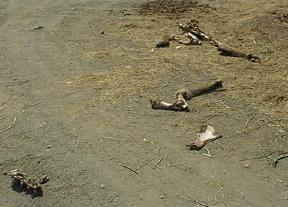 While one can at times be lulled into believing that the
animals at Kruger are almost tame, every once in a while you come across
evidence to the contrary. We found these remains of a lion kill at an observation
overlook. See why they tell you to remain in your car?
While one can at times be lulled into believing that the
animals at Kruger are almost tame, every once in a while you come across
evidence to the contrary. We found these remains of a lion kill at an observation
overlook. See why they tell you to remain in your car?
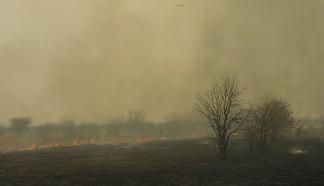 One of the tragic aspects of Kruger as it stands today is
that this year fully one quarter of the park has been burned. We even drove
through a fire line that crossed the main road. Almost all of the fires
are man-made; they're set by Mozambique "immigrants" crossing
the border through Kruger park and then sneaking out the park's western
fence. As the park is full of man-eaters, the immigrants set fires at night
to ward off the animals. One can see the glow of the fires at night as they
dot the eastern hills. The tragedy comes in the morning when the immigrants
move on, leaving their fires burning. When asked why, they all reply "the
fire is left for the next person coming through." The current South
African majority government does nothing to control the flow of immigrants
crossing Kruger or the damage they cause.
One of the tragic aspects of Kruger as it stands today is
that this year fully one quarter of the park has been burned. We even drove
through a fire line that crossed the main road. Almost all of the fires
are man-made; they're set by Mozambique "immigrants" crossing
the border through Kruger park and then sneaking out the park's western
fence. As the park is full of man-eaters, the immigrants set fires at night
to ward off the animals. One can see the glow of the fires at night as they
dot the eastern hills. The tragedy comes in the morning when the immigrants
move on, leaving their fires burning. When asked why, they all reply "the
fire is left for the next person coming through." The current South
African majority government does nothing to control the flow of immigrants
crossing Kruger or the damage they cause.
A lot of people in South Africa poo-poo Kruger Park. "It's too managed.", "The animals are too tame.", "We hate being seperated from the wildlife by fences." We have to disagree. We felt it was one of the most exciting national parks we've ever seen, and considered the five days we spent there a quality experience. Sure, there are other wildlife parks in Africa that offer different and/or more dangerous experiences, but that doesn't detract from what Kruger accomplishes in terms of wildlife protection or what it has to offer a visitor.
Vendu Region
After leaving Kruger we exited from the northern most gate and entered one of the former South African homelands, the Vendu Region. If you'll recall, South Africa set up the homelands as seperate countries in the 1970's, effectively partitioning off the majority of the black population so that it could claim that whites were the most populous group. Now reunited with South Africa, Vendu is the most "African" part of South Africa. We spent a few days here, visiting the Nwandedi Game Reserve and Sagole Spa. Both were once playgrounds for Afrikaners but since independence are now administered by blacks and don't receive many visitors. After Kruger, they both were primitive in creature comforts and quality of experience, but were worth visiting once. Darn inexpensive, though.
Gassy Spot
All the cruising we did with Spot in Kruger revealed one bad aspect: when driving slowly in the hot African sun, Spot has a tendency to smell like gasoline. So much so that Jim dismantled one of the carburetors and found that its metering float was nearly full of gas; whomever worked on it last reused all the seals (one was leaking), and that it hadn't been bolted on properly. Jim was able to deal with most of the problems; in particular he drained the float of gas and resealed it -- not a permanent fix, but one that hopefully will hold up long enough to find a parts shop with a new one.